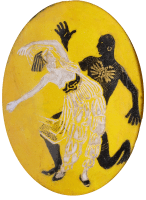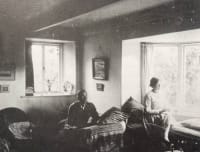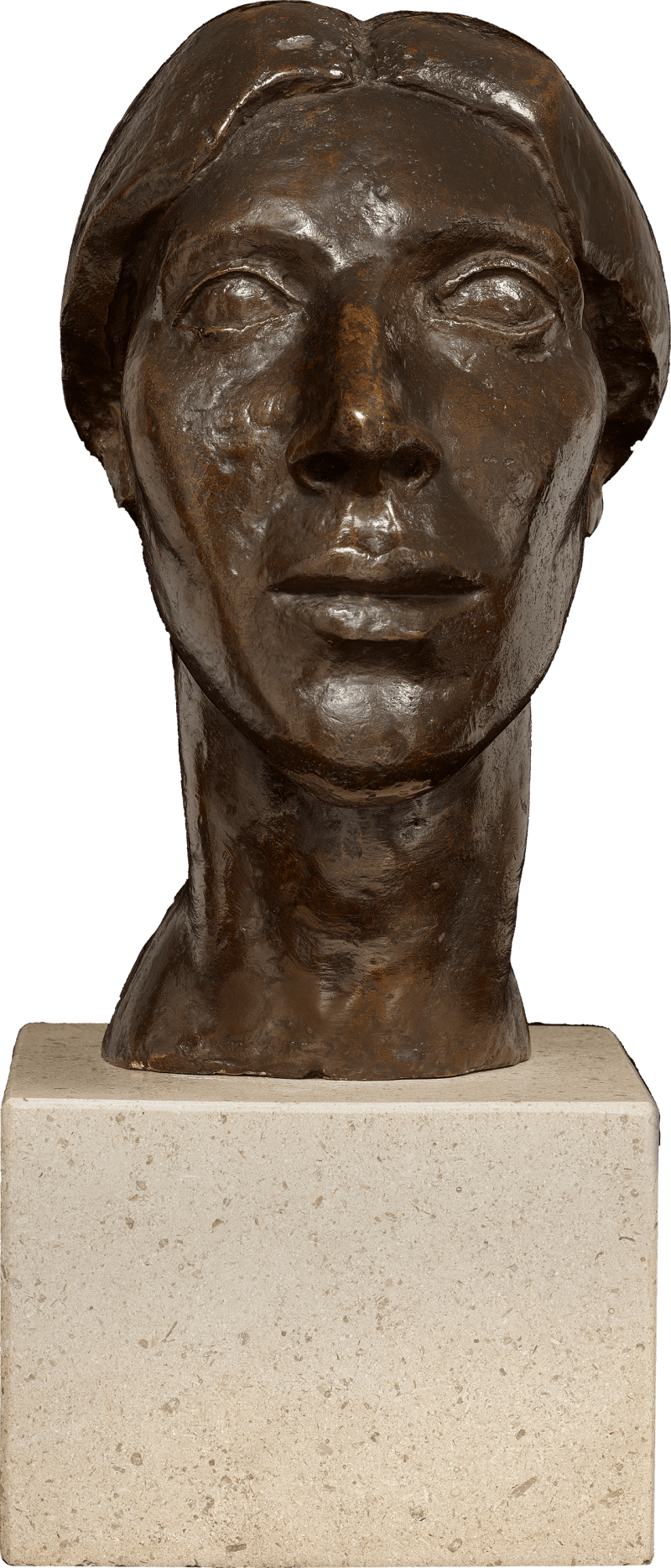Capturing the timeless drama of the Ballets Russes, Laura Knight produced this jewel-like portrayal of Anna Pavlova and Michael Mordkin as part of a small series of around nine enamels depicting ballet dancers in collaboration with the jeweller Ella Naper in 1914.
Knight’s enamels are a surprising departure from her oil paintings. They are miniature in scale but grand in ambition, requiring a sharp level of precision and patience. She had turned to enamel work under the watchful eye of her friend Ella Naper, who guided her through the challenging, almost alchemical process. Naper, working from her studio above Cornwall’s Lamorna Valley, became Knight’s collaborator and muse; she modelled for Knight’s notable 1913 Self Portrait with Model [fig. 1] and several of her celebrated coastal scenes, including Spring in Cornwall. The outbreak of the First World War brought constraints that restricted landscape painting along the coast, perhaps prompting Knight to turn her creativity inward. Together with Naper, she produced a...
Capturing the timeless drama of the Ballets Russes, Laura Knight produced this jewel-like portrayal of Anna Pavlova and Michael Mordkin as part of a small series of around nine enamels depicting ballet dancers in collaboration with the jeweller Ella Naper in 1914.
Knight’s enamels are a surprising departure from her oil paintings. They are miniature in scale but grand in ambition, requiring a sharp level of precision and patience. She had turned to enamel work under the watchful eye of her friend Ella Naper, who guided her through the challenging, almost alchemical process. Naper, working from her studio above Cornwall’s Lamorna Valley, became Knight’s collaborator and muse; she modelled for Knight’s notable 1913 Self Portrait with Model [fig. 1] and several of her celebrated coastal scenes, including Spring in Cornwall. The outbreak of the First World War brought constraints that restricted landscape painting along the coast, perhaps prompting Knight to turn her creativity inward. Together with Naper, she produced a series of dazzling enamels depicting ballet dancers and scenes of the Ballets Russes, now held in both private and public collections.
Knight had been mesmerised by the Ballets Russes when they performed in London during the years before the War. In particular, she became enamoured with the dancer Anna Pavlova. In her autobiography ‘The Magic of a Line’, Knight wrote: ‘The whole look of Pavlova had perfection of finish … But whatever the beauty of form may have been, she possessed an attraction all her own ... a something not of this world.’[1] With her keen eye for the spectacular, Knight captured Pavlova in mid-performance with her dance partner Michael Mordkin, rendered here in vibrant detail [fig. 2].[2] The present work was owned by Naper; another, related enamel was given by Knight to her friend and collector Marjorie Averill in 1958. In an accompanying letter to Averill, Knight wrote: ‘The enamel is Limoges, it is one of about eight I did in the year 1914 with the help of the jeweller, Mrs Ella Naper.’ In an amusing nod to the durable nature of the enamel medium, she added ‘You can’t injure this enamel except with a hammer or dropping it on a stone floor or treading on it.’[3]
For Knight, enamelling was a meticulous, intense departure from the spontaneous sketches she was known to capture directly from the theatre stalls. The process required precise firing of powdered glass onto metal, demanding near-clinical cleanliness to avoid the risk of cracking. Other examples from this series testify to the ambition and mastery Knight brought to this challenging medium. In June 1915, Knight exhibited her series of enamels at the Fine Art Society, London, some encased in Naper’s jewelled frames. John Branfield, author of ‘Ella and Charles Naper: Art and Life at Lamorna’, summarises the vivacious exhibition thoughtfully: ‘The mood of the show was meant to be sunny, to counteract the gloom about the war, and Ella’s jewellery sparkled.’[4]
[1] Laura Knight, (1965) The Magic of a Line. London: William Kimber, p.161.
[2] Another, related enamel identifies the figures as dancers Anna Pavlova and Mikhail Mordkin; sold Bonhams, London 27 September 2017, lot 124.
[3] Private collection; sold Bonhams, London 27 September 2017, lot 124.
[4] John Branfield, (2003), Ella and Charles Naper: Art and Life at Lamorna. Bristol: Sansom & Company, p.31.



















